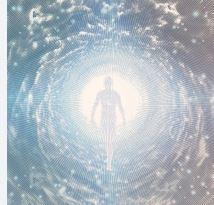Jenseits

The afterlife is a term for a non-physical, "other world" that is said to exist outside of our known reality – usually in connection with death and what comes afterward. How the afterlife looks or functions depends heavily on cultural, religious, or esoteric beliefs.
🌌 Generally speaking:
The afterlife is the place or state into which the soul or consciousness passes after death. It is often described as "subtle" or "transcendent" – meaning, not perceivable with our normal senses.
In esotericism:
Here, the afterlife is often very complex:
🔹 1. Different levels or dimensions
The afterlife is not a single place, but consists of several levels – from "lower," darker realms (e.g., for souls with a lot of unresolved karma) to "light" and higher levels of consciousness.
These levels are sometimes referred to as the astral world, the mental plane, the causal plane, etc.
🔹 2. Soul Journey After Death
After physical death, the soul goes through various phases:
Separation from the body
Review of the past life ("life film")
Contact with spiritual beings, ancestors, or teachers
Remaining at the appropriate level of consciousness (depending on the inner state)
Afterwards: Possible new beginning in the next life or further development on a non-material level.
🔹 3. Timelessness and other laws
Different rules apply in the afterlife: Time, space, and matter do not exist there as they do in our world.
Communication is often telepathic or purely energetic.
🔹 4. Contact from this world is possible
Mediums, clairvoyants, or sensitive people are said to be able to contact the afterlife – for example, through channeling, trance, dream messages, or automatic writing.
In other traditions:
Christianity: Heaven, Hell, Purgatory – depending on lifestyle.
Buddhism/Hinduism: Intermediate states (e.g., Bardo in Tibetan Buddhism) before reincarnation.
Shamanism: The afterlife is an "otherworld" with spirits, ancestors, and power animals that can be visited in a trance.

